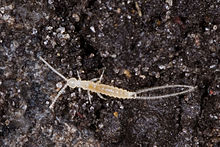Diplura
| Diplurans Temporal range:
| |
|---|---|

| |
| Campodea staphylinus, Belgium | |
| Scientific classification | |
| Domain: | Eukaryota |
| Kingdom: | Animalia |
| Phylum: | Arthropoda |
| Clade: | Pancrustacea |
| Subphylum: | Hexapoda |
| Order: | Diplura Börner , 1904
|
| Families [2] | |
| |
The order Diplura ("two-pronged bristletails") is one of three orders of non-insect hexapods within the class Entognatha (alongside Collembola (springtails) and Protura).[3] The name "diplura", or "two tails", refers to the characteristic pair of caudal appendages or filaments at the terminal end of the body.
Around 800 species of diplurans have been described.
Anatomy

Diplurans are typically 2–50 millimetres (0.08–1.97 in) long, with most falling between 7 and 10 millimetres (0.28 and 0.39 in).[4] However, some species of Japyx may reach 50 mm (2.0 in).[5] They have no eyes and, apart from the darkened cerci in some species, they are unpigmented.[5] Diplurans have long antennae with 10 or more bead-like segments projecting forward from the head.[6] The abdomens of diplurans bear eversible vesicles, which seem to absorb moisture from the environment and help with the animal's water balance.[6] The body segments themselves may display several types of setae, or scales and setae.[7]
Diplurans possess a characteristic pair of cerci projecting backwards from the last of the 11 abdominal somites.[8] These cerci may be long and filamentous or short and pincer-like,[9] leading to occasional confusion with earwigs.[10] Some diplurans have the ability to shed their cerci if necessary (autotomy). Moulting occurs up to 30 times throughout the life of a dipluran, which is estimated to last up to one year.
As entognaths, the mouthparts are concealed within a small pouch by the lateral margins of the head capsule. The mandibles usually have several apical teeth.[7] Diplurans do not possess any eyes or wings.[4]
In males, glandular setae or disculi may be visible along the first abdominal sternite. External genital organs are present on the eighth abdominal segment.[7]
Ecology
Diplurans are common in moist
Diplurans are found on nearly all land masses, except Antarctica and several oceanic islands.
Reproduction
Like other non-insect hexapods, diplurans practice
Lineages

Several major lineages within Diplura are readily recognizable by the structure of their cerci.
- Projapygidae: possess stout, short, and rigid cerci.[14]
- Campodeidae: possess elongate, flexible cerci that may be as long as the antennae and have many segments. Feed on soil fungi, mites, springtails, and other small soil invertebrates, as well as detritus.[3]
Relatives
The relationships among the four groups of hexapods are not resolved, but most recent studies argue against a
References
- ISBN 978-0-19-510033-4.
- ^ a b Maddison DR (January 1, 2005). "Diplura". Tree of Life Project. Archived from the original on October 17, 2012. Retrieved December 13, 2006.
- ^ a b c d e "Guide to New Zealand Soil Invertebrates". Massey University. 2006.
- ^ a b Bugguide.net. Class Diplura - Two-pronged Bristletails
- ^ a b Kendall D (2005). "Diplura". Kendall Bioresearch Services.
- ^ a b c d "Diplura". McMaster University. 1999. Archived from the original on 2007-03-27.
- ^ JSTOR 25078790.
- ^ "Diplura". The Earthlife Web. November 11, 2005. Archived from the original on 2006-12-05.
- ^ "Diplura". Iziko Museums of Cape Town. 2004. Archived from the original on 2007-09-26.
- ^ CSIROEntomology.
- ^ a b c Meyer JR (2005). "Diplura". North Carolina State University. Archived from the original on 2012-02-05. Retrieved 2006-12-13.
- S2CID 19040885.
- – via Dialnet.
- .
- .
External links
 Data related to Diplura at Wikispecies
Data related to Diplura at Wikispecies
